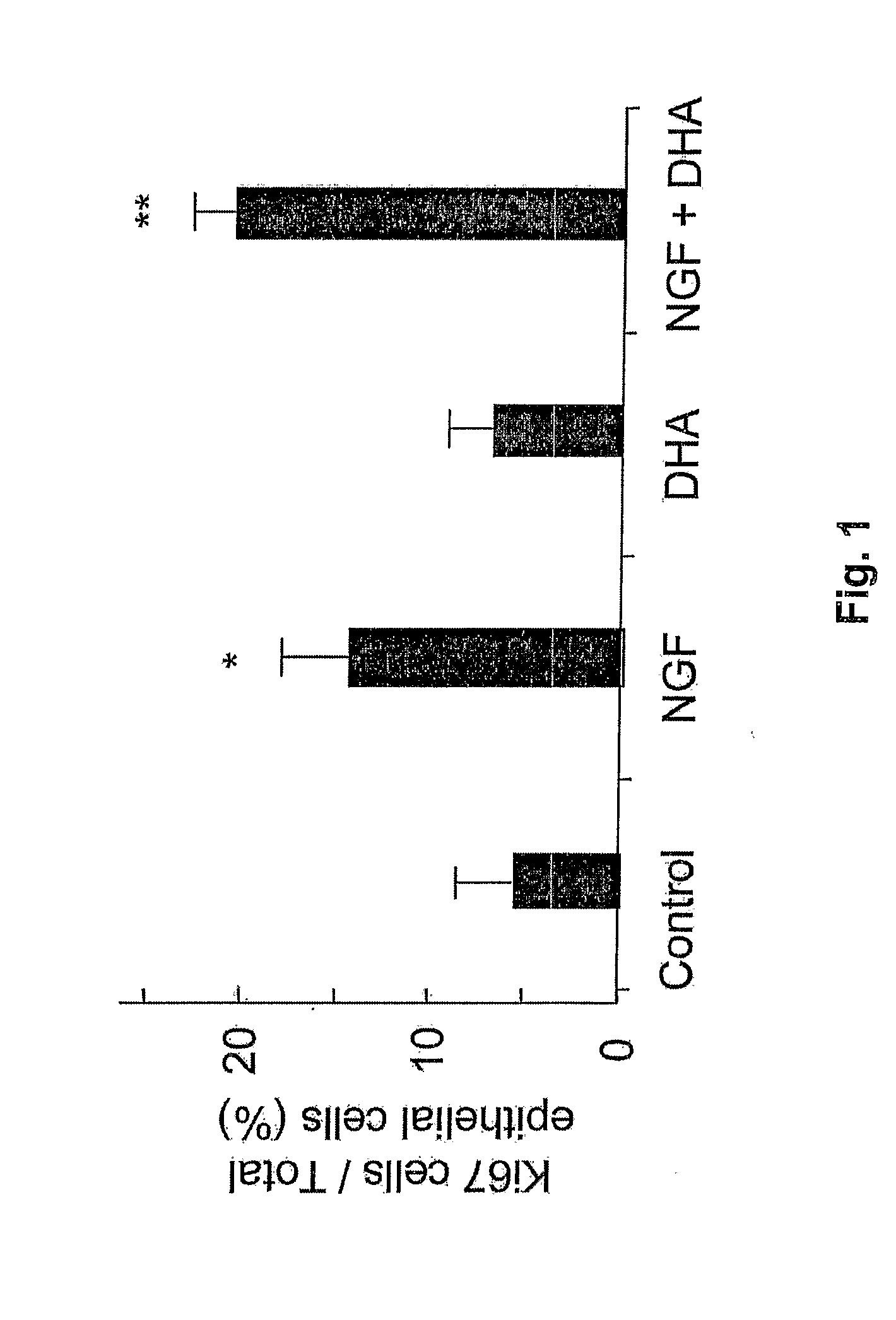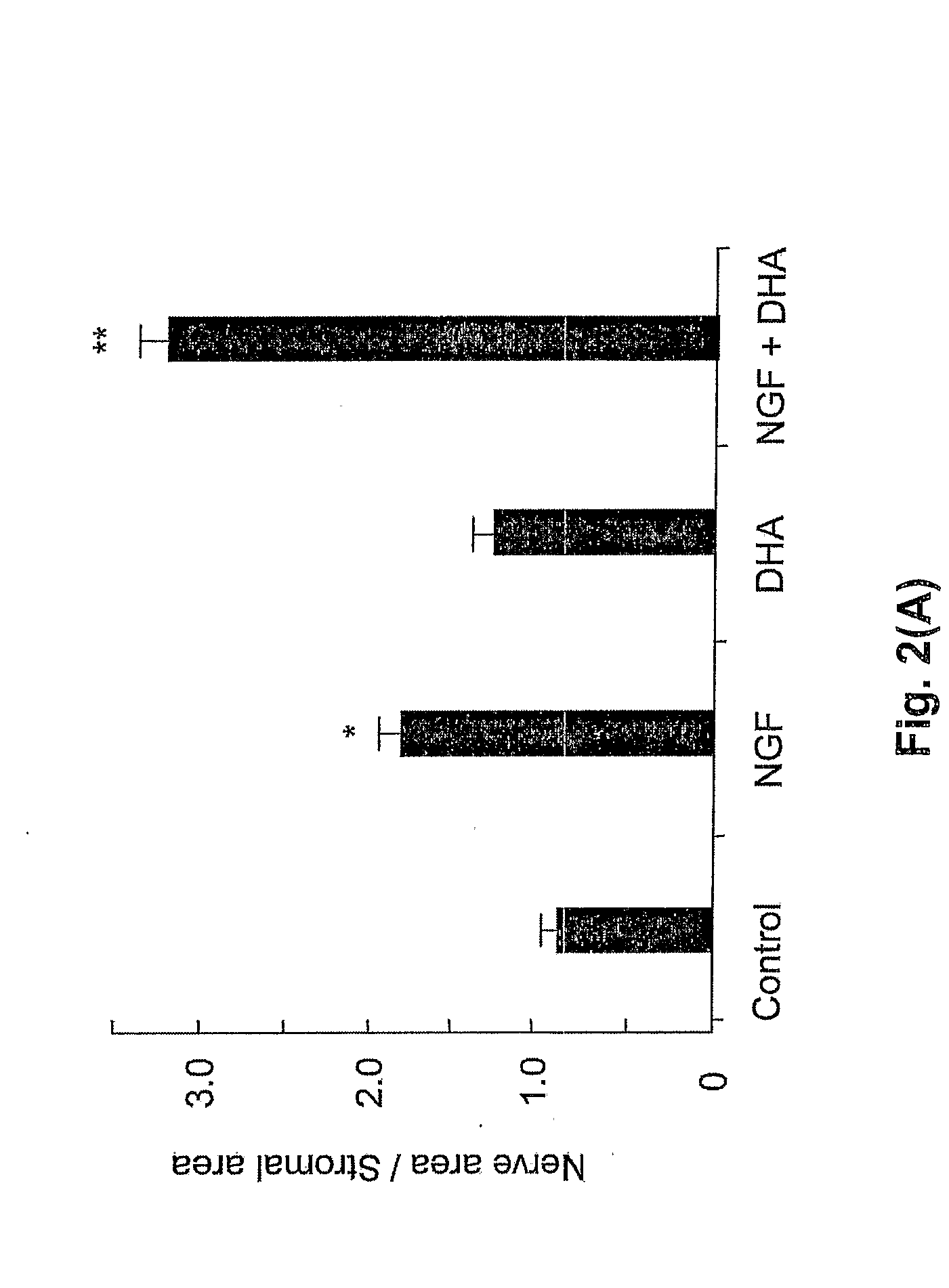Topical Treatment with NGF and DHA in Damaged Corneas
- Summary
- Abstract
- Description
- Claims
- Application Information
AI Technical Summary
Benefits of technology
Problems solved by technology
Method used
Image
Examples
example 1
Materials and Methods
[0016] Photorefractive Surgery
[0017] Twenty-one New Zealand albino rabbits weighing 1.5 to 2.0 kg were obtained from a commercial supplier and were treated in accordance with the guidelines of the Association for Research in Vision and Ophthalmology. Each rabbit received intramuscular xylazine (10 mg / kg) and ketamine hydrochloride (50 mg / kg) anesthesia. Tetracaine eye drops were used as topical anesthesia. Tear secretion tests (e.g., tear break-up time, Schirmer's test, and rose bengal staining) were performed preoperatively under general anesthesia. Each rabbit received a unilateral PRK laser treatment. The corneal epithelium was removed with an epithelial scrubber (Katena Inc, Denville, N.J.). An excimer laser ablation to correct −5 diopters of myopia using a 6.5 mm optical zone (Lasersight Technologies, Inc., Winter Park, Fla.) was performed. The eye was washed with balanced salt solution. Lubricating eye drops and an ophthalmic solution of 0.3% ofloxacin ...
example 2
Absorption of DHA-Albumin Solution by Collagen Shields
[0024] Measurements of the absorption of the DHA: albumin solution by the collagen shields were performed through tandom mass spectrometry analysis. Corneal shields were soaked with the DHA: albumin solution overnight. The shields were washed in PBS (pH 7.4), and then extracted in 1 ml 100% methanol, followed by a 1 ml methanol wash. Collected solvent extracts were dried under nitrogen and re-suspended in 1 ml methanol. The samples were then analyzed using a liquid chromatograph-tandem mass spectrometer (LC-MSMS; LC-TSQ Quantum, Thermo Electron Corp.; Waltham, Mass.), installed with a Biobasic-AX column (Thermo-Hypersil-Keystone) and eluted with 100% solution A (40:60:0.01 methanol / water / acetic acid; pH 4.5) to 100% solution B (99.99:0.01 methanol / acetic acid)], at a flow rate of 300 μl / min for 30 minutes. LC effluents were diverted to an electro spray-ionization probe (ESI) on a TSQ Quantum (Thermo Electron) triple quadrupole ...
example 3
Tear Secretion Tests
[0026] Tear secretion tests (tear break-up time, Schirmer's test and rose bengal staining) were performed every 15 days over the 8-week period following PRK. All the tests were performed with general anesthesia. Schirmer's test was performed using the recommended method with the Alcon test strips (Alcon Laboratories; Forth Worth, Tex.). The tear break-up time test was performed using fluorescein strips (Akorn Inc.; Lincolnshire, Ill.) that were moistened with non-preserved saline solution. Rose bengal staining was performed with Barnes / Hind strips (Akorn, Inc.). Three or mnore punctate spots of staining on the cornea were required to consider the stain positive. All measurements were conducted in a blinded fashion.
[0027] The animals tolerated the treatments well, and no adverse reactions were noted throughout the length of the experiment. No significant difference was found in tear secretion, as measured by Schirmer's test, at any time point (Table 1). Fifteen...
PUM
| Property | Measurement | Unit |
|---|---|---|
| Length | aaaaa | aaaaa |
| Length | aaaaa | aaaaa |
| Time | aaaaa | aaaaa |
Abstract
Description
Claims
Application Information
 Login to View More
Login to View More - R&D
- Intellectual Property
- Life Sciences
- Materials
- Tech Scout
- Unparalleled Data Quality
- Higher Quality Content
- 60% Fewer Hallucinations
Browse by: Latest US Patents, China's latest patents, Technical Efficacy Thesaurus, Application Domain, Technology Topic, Popular Technical Reports.
© 2025 PatSnap. All rights reserved.Legal|Privacy policy|Modern Slavery Act Transparency Statement|Sitemap|About US| Contact US: help@patsnap.com



